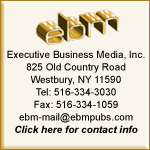
Return to
Home Page
Link to Our Advertisers

Return to EBM
Corporate Home Page
Contact Information Subscribe Archives EBM HOME

|
EXECUTIVE
COMMENTS:
Pitfalls to Avoid
|
|
In the retail family, nationally known names like Wal-Mart, Best Buy, RadioShack and Circuit City are the overachievers who are the envy of their less-accomplished and somewhat jealous brothers, sisters, cousins and other relatives.
With thousands of stores across the country, Wal-Mart, Best Buy and the like have the enviable advantage of leveraging immense size to gain volume pricing and other concessions from suppliers, much to the dismay of resentful and defensive smaller-scale retailers. At annual family reunion picnics, however, the working-class side of the retail clan can take some restitution. The flashy big-box boy's business advantages are offset by deficiencies in customer service, an area where smaller retailers often have the upper hand. College stores often hear from experts that clues to student expectations regarding merchandise and shopping experience are found in national retailers. Students belong to an age group that shops these stores in the years before college and arrive on campus anticipating consistency. By visiting the stores and noting the variety of merchandise, it is suggested campus retailers can get ideas regarding assortment, display, fixturing and floor planning. Not everything about national retailers is worthy of being copied by college stores or used as a benchmark. In fact, some lessons are more about examples of mistakes college stores should avoid repeating. Forrester Research, an independent technology and market research company providing advice about technology's impact on business and consumers, recently evaluated how well four national retailers help customers to select a digital camera. Results of that evaluation, “The In-Store Experience: Selecting a Digital Camera,” revealed clues college stores can apply to enhance the experience of shopping not only for consumer electronics, but other categories, too. Essentially, Forrester argues that customers come into a store just to browse or with a specific purchase in mind, but often have not made the choice of what will best suit their need. In the store, customers look for information to make that decision, and Forrester identified shortcomings in national retailers that college stores can learn from to improve service. Forrester identified four keys to simplify decision making by organizing how customers find departments and compare choices, then encouraged retailers to further assist with selection by featuring detailed information. Another suggestion is for stores to tap into Web assets, such as having kiosks on the sales floor where customers can research additional merchandise information that retailers store online. Although Forrester is talking about buying digital cameras, college stores can easily apply these suggestions to other merchandise. Bookstores rank among the most prominent elements of a higher education institution's academic identity, and a destination for visitors and the community. The problem is visitors, incoming students, transfers, parents and others who are becoming acquainted with the store and its assortment require orientation. Shoppers, whether visitors or students on campus for the academic term, are best served by information to make accurate, useful purchasing decisions. Visitors may need to decide on gift items, students on the correct textbook or supplies. Signs need to make the path to departments clear to customers upon entering the store. In a merchandise department, merchandise should be logically organized with content to help customers narrow down options. Additional information in the form of tags and booklets can explain differences for customers to compare choices. This is already done in textbook departments, where shelf tags associate books with specific courses and sections. Have stores ever recruited a volunteer to test how long it takes to find a set of books for a fictional schedule and identify any hurdles that could be removed to improve the experience? How well do stores help to quickly recognize the differences in apparel choices or options in other departments, other than by guessing according to the price? Trade books are typically organized into fiction and nonfiction, then according to subject, such as history or business, and alphabetically by author. Could a similar strategy be applied to other departments? How well college stores simplify the customer shopping experience could become an essential aspect of future success, and maybe earn a little more loyalty from customers facing numerous choices of where to spend money. The best investment college stores can make is to evaluate how customer friendly their own store really is. |
 |
Click on a title to link to
an EBM publication: |
Contact Information Subscribe Archives EBM HOME